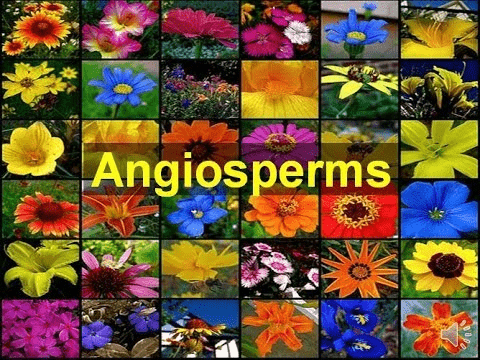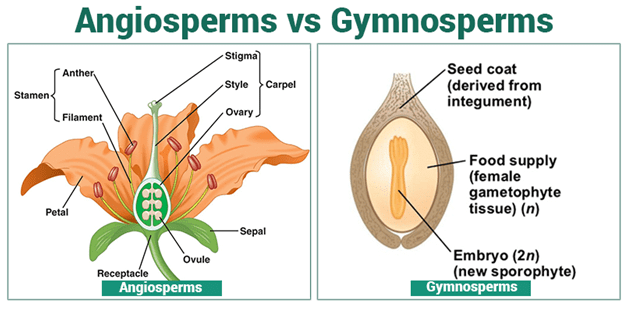Detailed Notes: Angiosperms | Biology for ACT PDF Download
| Table of contents |

|
| Angiosperms |

|
| Characteristics of Angiosperms |

|
| Classification of Angiosperms |

|
| What are Angiosperms and Gymnosperms? |

|
| Difference between Angiosperms and Gymnosperms |

|
Angiosperms
 Angiosperms are vascular plants with stems, roots, and leaves. The seeds of the angiosperm are found in a flower. These make up the majority of all plants on earth. The seeds develop inside the plant organs and form fruit. Hence, they are also known as flowering plants.
Angiosperms are vascular plants with stems, roots, and leaves. The seeds of the angiosperm are found in a flower. These make up the majority of all plants on earth. The seeds develop inside the plant organs and form fruit. Hence, they are also known as flowering plants.
Angiosperms are the most advanced and beneficial group of plants. They can grow in various habitats as trees, herbs, shrubs, and bushes.
Characteristics of Angiosperms
- Angiosperms have diverse characteristics. The important characteristics of angiosperms are mentioned below:
- All plants have flowers at some stage in their life. The flowers are the reproductive organs for the plant, providing them with a means of exchanging genetic information.
- The sporophyte is differentiated into stems, roots, and leaves.
- The vascular system has true vessels in the xylem and companion cells in the phloem.
- The stamens (microsporophyll) and the carpels (megasporophyll) are organized into a structure called the flower.
- Each microsporophyll has four microsporangia.
- The ovules are enclosed in the ovary at the base of the megasporophyll.
- Angiosperms are heterosporous, i.e., produce two kinds of spores, microspore (pollen grains) and megaspores.
- A single functional megaspore is permanently retained within the nucellus.
- The pollen grains transfer from the anther to stigma and reproduction takes place by pollination. They are responsible for the transfer of genetic information from one flower to the other. The pollen grains are much smaller than the gametophytes or reproductive cells present in the non-flowering plants.
- The sporophytes are diploid.
- The root system is very complex and consists of cortex, xylem, phloem, and epidermis.
- The flowers undergo double and triple fusion which leads to the formation of a diploid zygote and triploid endosperm.
- Angiosperms can survive in a variety of habitats, including marine habitats.
- The process of fertilization is quicker in angiosperms. The seeds are also produced quickly due to the smaller female reproductive parts.
- All angiosperms are comprised of stamens which are the reproductive structures of the flowers. They produce the pollen grains that carry the hereditary information.
- The carpels enclose developing seeds that may turn into a fruit.
- The production of the endosperm is one of the greatest advantages of angiosperms. The endosperm is formed after fertilization and is a source of food for the developing seed and seedling.
Classification of Angiosperms
The classification of angiosperms is explained below:
Monocotyledons
- The seeds have a single cotyledon.
- The leaves are simples and the veins are parallel.
- This group contains adventitious roots.
- Each floral whorl has three members.
- It has closed vascular bundles and large in number.
- For eg., banana, sugarcane, lilies, etc.
Dicotyledons
- The seeds of these plants have two cotyledons.
- They contain tap roots, instead of adventitious roots.
- The leaves depict a reticulate venation.
- The flowers are tetramerous or pentamerous and the vascular bundles are organized in rings.
- For eg., grapes, sunflower, tomatoes, etc.
The angiosperms originated about 250 million years ago and comprise 80% of earth’s plant life. They are also a major source of food for humans and animals.
What are Angiosperms and Gymnosperms?
Angiosperms and gymnosperms are both seed-bearing plants with a few similarities. This is due to the fact that gymnosperms were present for at least 200 million years before the angiosperms evolved and they may have shared a common ancestor.
The main difference between angiosperms and gymnosperms is their diversity. The diversity of angiosperms is greater than the gymnosperms. The higher diversity indicated the angiosperms adapted to a wide plethora of terrestrial ecosystems. Another characteristic of angiosperms is the flowers and production of fruits.
 |
Download the notes
Detailed Notes: Angiosperms
|
Download as PDF |
Difference between Angiosperms and Gymnosperms
Following are the important difference between angiosperms and gymnosperms:

Angiosperms
The word angiosperm is derived from Greek, which translates to a “container.” As the name suggests, the angiosperms are vascular plants, which bears seeds in fruits or mature ovaries. Angiosperm forms flower that carries reproductive organs and fruits. These plants are more adaptive to the terrestrial habitat and have a very wide distribution, around 250000 species have been identified to date.
Angiosperm Examples
Fruits trees including Mango, Apple, Banana, Peach, Cherry, Orange, and Pear often shows flowers before they bear fruits and the pollination process is generally carried out by agents such as bees.
Grains including rice, corn, and wheat are also examples of Angiosperm. In these plants, the pollination process is carried out by the wind. Other examples of Angiosperms include roses, lilies, Broccoli, kale, Petunias, Eggplant, Tomato, Peppers and sugarcanes.
Gymnosperms
Gymnosperms are other types of plant that bear seeds directly on sporophylls without covering. As the name suggests the gymnosperms are vascular plants of the Kingdom Plantae which bear naked seeds. There are very fewer species of gymnosperms, few examples of these plants are cypress, Gnetum, pine, spruce, redwood, ginkgo, cycads, juniper, fir, and Welwitschia.
The main reason for being very fewer species is the lack of protection of seeds. The seeds are naked and unprotected when released. They need to get into the ground quickly to take root or they will be damaged by animals, weather conditions or any other factors.

|
208 videos|226 docs|136 tests
|
FAQs on Detailed Notes: Angiosperms - Biology for ACT
| 1. What are the characteristics of angiosperms? |  |
| 2. How are angiosperms classified? |  |
| 3. What are angiosperms and gymnosperms? |  |
| 4. What is the difference between angiosperms and gymnosperms? |  |
| 5. What are some examples of angiosperms and gymnosperms? |  |























